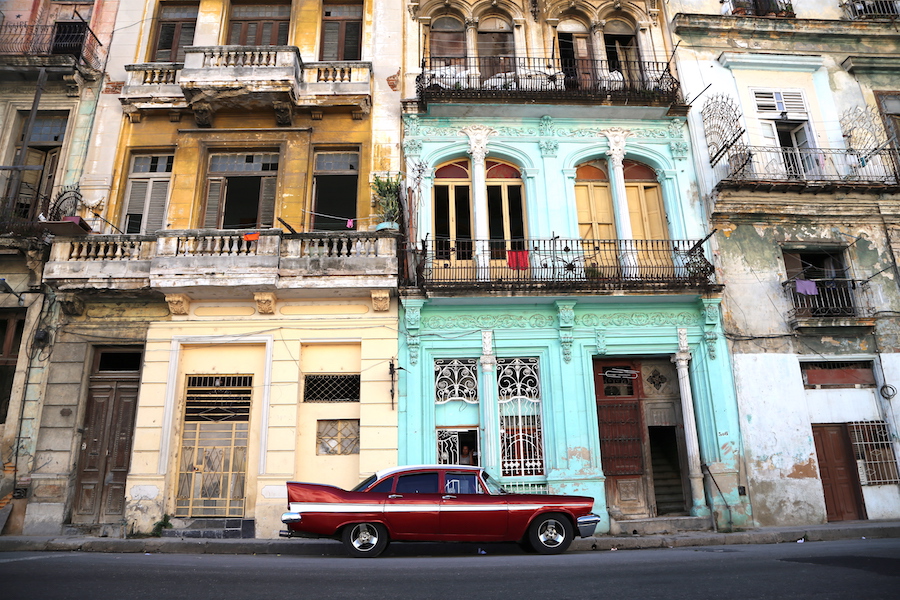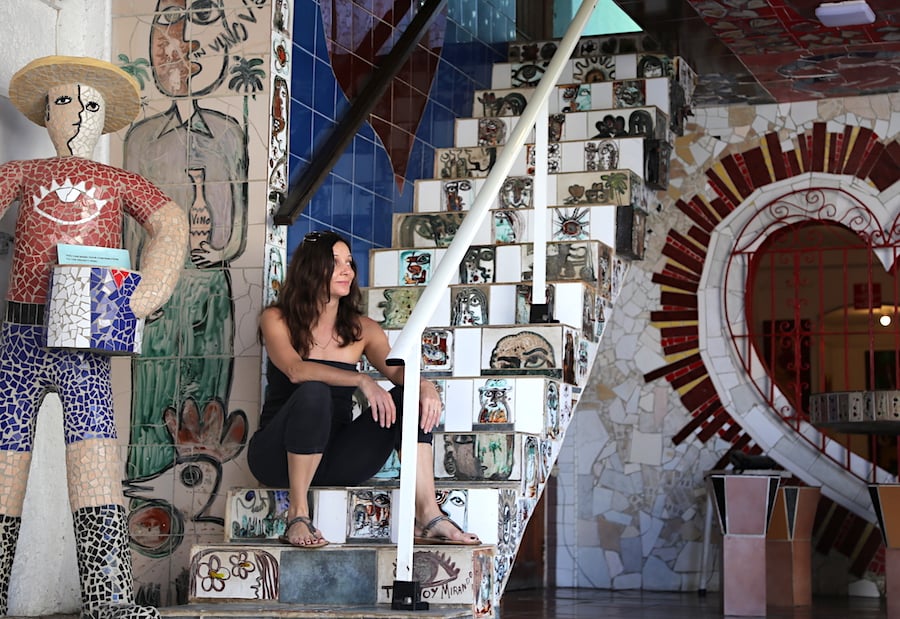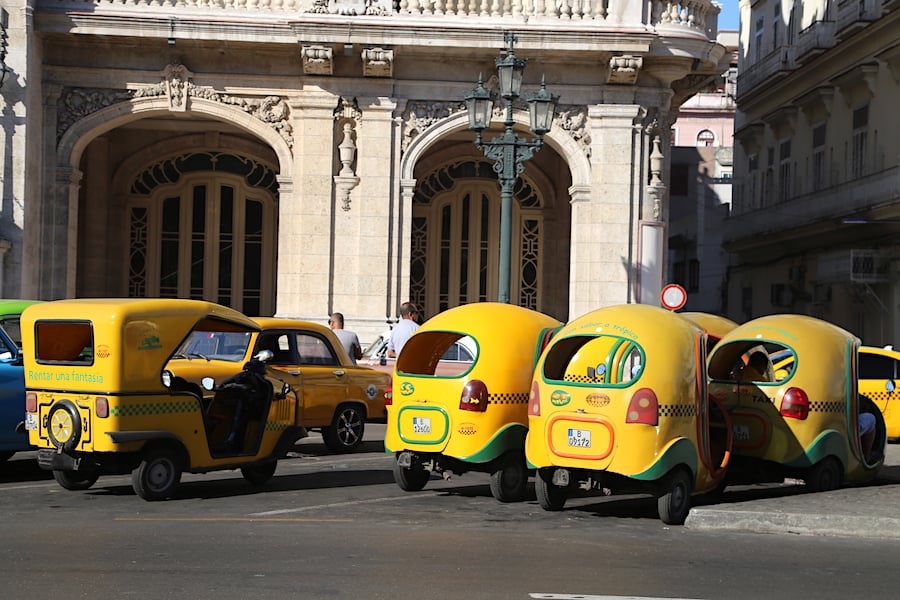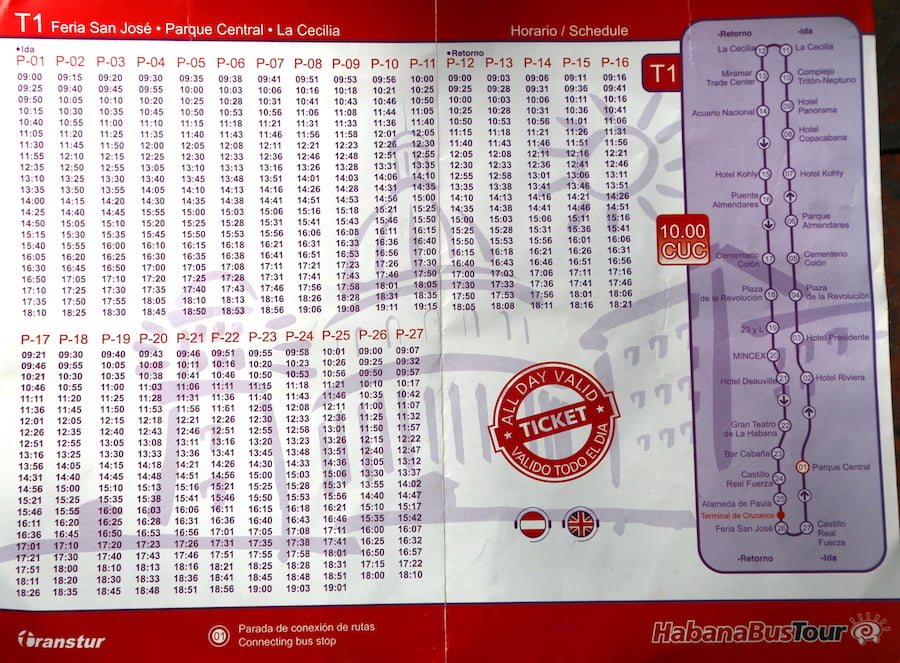There was so much excitement when booking my trip to Havana, but there was also a little bit of uncertainty. The embargo, that dates back to the 1960s, made most travel to Cuba by Americans off-limits. It hasn’t been long since Cuban and American relations have improved and the embargo has loosened, which allows United State citizens to travel to the country with less regulations.
Since more Americans traveling to Cuba is fairly new, getting the proper information about how to travel to Havana was tricky for me, so I took detailed notes from my trip in hopes that the lessons learned will make it easier for you.
Here are the things you need to know about traveling to Havana.
An American Traveling to Havana: What You Need to Know to go to Cuba
How to Enter
It is still illegal for Americans to enter Cuba solely as a tourist, you technically can’t just go to ride in a pink vintage convertible or smoke Cuban cigars with the locals. Visiting will require you fit into one of these 12 categories:
- Family visits
- Official business of the U.S. government, foreign governments, and certain intergovernmental organizations
- Journalistic activity
- Professional research and professional meetings
- Educational activities
- Religious activities
- Public performances, clinics, workshops, athletic and other competitions, and exhibitions
- Support for the Cuban people
- Humanitarian projects
- Activities of private foundations or research or educational institutes
- Exportation, importation, or transmission of information or informational materials
- Certain authorized export transactions
Most people will choose education activities, where you will need to have a full itinerary of activities designed for people-to-people contact with the Cuban citizens.
I claimed journalist, which was the obvious selection for me. This choice was stated when booking my flight online with JetBlue and my lodging with Airbnb.
Besides those two times, not one person asked why I was in Cuba.
No one asked when entering the country, while in the country or even upon returning to the United States.

Getting There
You used to have to be tricky when going to Cuba by flying to a place like Cancun first and then transferring to Cuba on a separate flight booking. This worked because Cuba reportedly used to not stamp US passports, so when you returned if just looked like you had a nice vacation in Mexico. Well, they are stamping passports now (there’s a pretty one in my passport now!), plus with the loosened regulations and direct flights it is easier than ever to travel there.
You no longer need to fly to Mexico to get to Cuba.
There are several airlines now flying there from the United States:
I booked my flight through JetBlue for a screaming good deal ($375 RT from SFO), and had a layover in Fort Lauderdale, Florida before taking the hour flight to Havana.
NOTE: You should go directly to the airlines website to search for flights. If you look at an aggregator site, like Tripadvisor, you will come up with this warning: “TripAdvisor is unable to show requested itineraries or travel plans that include Cuba due to U.S. government regulations.”

Documentation
All the documentation requirements initially seemed really confusing to me, but in reality it was actually really simple.
Visa
You need a Visa to enter Cuba and you can easily get one at your gateway airport, either at the check-in or gate counter, just ask your airline for instructions.
For me, at the Fort Lauderdale airport gate we were instructed to go to the JetBlue counter adjacent our departure gate. They collected the $50 fee, gave me the visa and a green stamp on my boarding pass to indicate my documents had been checked. I returned back to the gate and boarded the plane. Easy peasy.

Health Insurance
A special health insurance that covers the territory of Cuba is required, but this $25 insurance was included in the cost of my flight with Jet Blue, which is typical for most airlines flying from the US to Cuba, so check with your airline.
While on the plane we were given a Health documentation to be filled out (basically just a questionnaire about illnesses you have recently had). After immigration and security, there were tables where these forms were dropped off. Basically, the attendant quickly glanced at them to make sure they were filled out properly and then waved you on. I was never asked to provide an insurance document.
Custom Forms
Though some flights will pass out custom forms while in air, we were told that the blue customs forms could be picked up upon arrival. If your flight attendant doesn’t pass out these forms they can be found right after the immigration check, at the security station. There should be some on the shelf on top of the conveyor belt.
After security, we picked up our bags then went through the “Nothing to Declare” section and gave them the customs form. Then we were in the arrival hall.
NOTES:
- Make sure to bring a pen!
- After landing, getting through immigration, security, customs, health form drop-off and picking up luggage, took about 45 minutes (a half hour of that was actually waiting for the luggage). During this process, no one asked why I was in Cuba.

Currency & Credit Cards
Credit Cards
American credit cards and debit cards are banned in Cuba so you need to make sure to bring enough cash to get you through your entire visit.
How much money should I bring?
My husband and I brought 750 euros for a full 4-days in Havana and spent $700, $87.50 per person per day. This figure does not include lodging and two tours which were booked and paid for online prior to arrival.
If you are a budget traveler, you could fairly easily get by in Havana on much less ($30-$50 per person per day), not including hotel. We spent a bit more because we ate at the fanciest restaurants, drank a lot of mojitos, took taxis everywhere and bought quite a few internet cards.

Currency
There are two types of currency in Cuba: the tourist CUC & the local CUP. Cubans carry both types of cash and know where to use each. But, in most cases, tourists can get by with just CUCs.
I only exchanged my money for the tourist CUC and did not encounter any need to have the other. With that said, many smaller privately owned shops, especially inexpensive street food stalls, will have prices in CUP, so know the exchange rate which is currently 1 CUC = 26.50 CUP (you can check the current exchange rate here). Most of these shops will now accept CUCs, but many will not have change for higher bills, and any of your change will be in CUP. So if you are paying at a CUP place make sure you use the lowest denomination of CUC to pay or else you will be stuck with lots of CUPs that you may not be able to get rid of. Always have some $1 bills and coins available for these cases.
The CUC exchange rate is approximately:
- $1 USD = 1 CUC (check current rate)
- 1 Euro = 1.06030 CUC (check current rate)
- 1 CUC = 26.50 CUP (check current rate)
Exchanging Money
If you are a US citizen it is better to exchange your money to Euros prior to arriving in Cuba because there is a 10% tax to exchange USD to CUC. I exchanged my USD to Euros at my bank in Northern California (and brought some backup USD just in case).
It was not an option to exchange my USD into Cuban money while in the US.
You can exchange money at the Havana airport, and will need to if you plan on taking a taxi from there. There are exchange booths (Cadecas) upstairs on the second floor after you exit customs or others outside the arrival doors on the ground floor. You can’t miss them with their large yellow signs and long lines. I checked all of the booths before deciding which one to stand in line at and the lines were about the same – very long.
Check to see how many tellers each booth has before making your decision (some will have only one, while others may have two). Because all lines were about the same, with the same number of tellers, I opted to wait at the indoor exchange booth on the second floor due to the hot weather outside!
It took an excruciatingly long hour and forty-five minutes to get through the line!!!

Towards the end of our wait, I did notice some people at the back of the line making little side deals. Someone who wanted to exchange their leftover CUCs to Euros bargained with someone else in line who needed the CUCs just for a taxi. I’m sure there are some sort of legalities against that, but I thought it was brilliant as it saved them a couple hours of waiting in line!
When we were departing Havana I noticed that the exchange booths were about half the length (of course!). I hope you are so lucky to catch it at the right time, but be prepared to wait.
You can also typically exchange money at larger, state run hotels and there are some banks/exchange booths scattered throughout old town Havana, but they had fairly long lines too. I exchanged all my Euros at the airport, because I didn’t want to wait in any more lines and I needed a taxi anyway.
NOTE: When exchanging money always ask for small bills, $20s and $50s are hard to get rid of as many shops and taxi drivers will not have change for that high of a bill. Having mostly $1, $3 and $5 works best. If you have $20s always use them in the hotels or nicer restaurants who will most likely have change, then save the smaller denomination for street food, privately owned shops and tipping.

Tipping
Most Cubans earn less than 30 CUC per month, so tipping is really appreciated. Leaving a 10% tip is the average, but realize that some restaurants will already include a 10% service charge on your bill, so double check.
Read More > Tipping in Cuba: Who Should I Tip and How Much?
Getting Around
Since internet is very limited and you most likely won’t have GPS, having some sort of a map will make your daily itinerary planning much easier. In most cities you can download an offline Google map, but at post time that is not possible for Havana (take note that with the new regulations this can change at any time). You can try the app Map of Cuba Offline, but I would also recommend buying a map at the airport. You can find them on floors 1 and 2 for between 3-5 CUC depending on the size. Or the StreetSmart map on Amazon beforehand.
There’s an array of transportation options in the city, especially in the center of the action in Old Havana. You can almost always find a taxi, bus, bicycle or horse cart to take you where you need to go, plus the city center is very walkable.

Airport Taxi
You will be bombarded when you cross past customs with taxi offers, many of whom say that they will take you to the bank. Believe me, after the long currency exchange wait in line, it did sound like a really good deal! But, many of these drivers have privately owned taxis. Some will not have seatbelts or the drivers won’t know simple directions to your destinations. Instead opt for the legit yellow taxis that are just outside the arrival doors. These cars are more likely to be fairly priced and have seatbelts! There was a main guy holding up a yellow taxi sign and he led us to one of the cars.
NOTE: Make sure to negotiate the price before you get into any taxi, because even though some have meters, they are hardly ever used.
It cost 30 CUC for us to get from the airport to Hotel Presidente in Vedado, about 7 minutes from old Havana. Depending on the season, you may be able to negotiate a little cheaper rate.

Yellow Taxis
As I said before, yellow taxis are known to be the most legit and most of the major places around Havana will have at least a half dozen of them waiting out front, so it should never be too hard to find one. Always negotiate on pricing, but you should typically never pay more than 10 CUC to get anywhere in central Havana, 7 CUC is more like it if you are really good at negotiating. I only broke this rule once and paid 15 CUC because it was raining and there were no other taxis around. Sucker!
You can also hire the yellow taxis by the hour which we did for 3 hours on our last day in Havana. We paid $50 for the driver to take us to about 7 destinations for 3 hours. Typical hourly prices are anywhere between 15-20 CUC.
Other random taxis
There will be other random “taxis” at some locations offering you a great deal, but most won’t have seat belts and some don’t know where they are going unless the destination is to a major landmark. With that said there may be times when you have to take one. When we were having a late night dinner at El Cocinero the only option was these sorts of taxis, there were no yellow ones in sight. The price was the same, but the guy had no idea where our destination was (he had to stop to ask some locals) and the car didn’t have seat belts. Though, I did feel that he was really appreciative for being able to earn the money.
NOTE: Always have the address of your destination and closest major landmark available for the driver. I always kept this information on my phone and just showed it to them when we hopped in.

Hop on off bus
The Hop on Hop Off Bus is a great way to get an overview of the city and to see some of the major sites, but not to just strictly get from one destination to the next, because it will take forever! There are currently two routes: the T-3 costs 5 CUC and the more popular T-1 is 10 CUCs for an all-day pass (you can buy tickets from the attendant on the bus).
You can catch the bus at any stop, but the most popular is Parque Central, where it is easy to walk to Old Havana from.
NOTE: When you’re riding on the open-air top it’s really hard to tell what are stops and it seemed like they bypassed a few that are on the map, so pay attention!! They do always stop at Parque Central in front of Hotel Inglaterra, so this is a good starting and ending point.


Classic Convertible Cars
You’re in Havana, so you will probably want to ride in one of those snazzy classic convertibles. The cost can range from $25 CUC to $50 CUC per hour depending on the tourist season and where you want to go. Again, always negotiate!
The fanciest convertibles will be on the higher end and one of the jalopies on the lower. We took a Vintage Classic Car Tour for $50 per person, and it included an hour ride in a pretty convertible. Otherwise, there are a dozen drivers with their beautiful cars in front of Hotel Inglaterra at Parque Central ready to take you for a ride.

Accommodations
If you start your hotel search on a place like Expedia or Booking.com, you will begin to get worried. There are only a handful of hotels in Havana and they are mostly owned by the government, so are very expensive (typically $300+ per night). These are the ones that these hotel websites will show and many of them will be sold out.
It is more common for visitors to stay in a Cuban’s private home or B&B, which is way more economical and a local experience. Head over to Airbnb because this is where most of these types of lodgings are listed. You can easily find a room in a cute house for under $50 per night.
I stayed at the lovely Mi Casa Tu Casa, which was a little pricier at $125 per night. But, it had excellent reviews, breakfast was included and there was internet access. Plus, its location was right across the street from the larger Hotel Presidente, where the hop on hop off bus stopped, there were always taxis available, we could exchange money and listen to music on the patio. It was a lovely stay and I would highly recommend it!
NOTES:
- Make sure to read the reviews on Airbnb, so you can ensure that you are booking the best place for your needs
- Cubans have limited internet access, so response time to emails can be slow. If this makes you nervous, I’d recommend using Airbnb’s instant bookings.

Internet Access
Cuba is not like America where virtually every home has a strong internet connection and everyone is walking down the street with their noses in their phones. Havana has limited internet hotspots and you need a card in order to tap into them. Even when some hotels or cafes say that they have Internet, that just means that they are an internet hotspot, but you will still need to purchase a card in order to use it.
There is no such thing as free internet in Cuba.

Cards typically run from 1.50 – 3 CUC for an hour of internet time depending on where you buy them. You’ll can buy them at an ETECSA telecommunications centre (very long lines!) or select hotels (though many will only sell them to their guests).
On some random corners you’ll notice a lot of people loitering on their cell phones. This is a wifi hotspot and there will typically be people selling a little bit more expensive internet cards, but there won’t be a line!

Logging in
Logging on is fairly simple. You will choose the internet network (you must be near a hotspot) and then a box will appear asking for the login and password information on the card. Once it’s filled out properly you will get a confirmation in the same box and the one hour timer will start. Don’t worry, you don’t have to use the entire hour in one shot, you can log out and the time will pause.
NOTES:
- An hour goes by quickly, so make sure to have everything you need before you log on. Most Cubans will already have their emails written and todo lists ready before logging on.
- Just an FYI that I had no problem accessing and posting to all the social media sites when there was a strong connection.
I hope with these tips it will make you less fearful about traveling to Cuba to check Havana off your bucket list!
Traveling Soon? Use my Favorite Resources for Booking Your Trip!
Book Your Flight
Skyscanner is my favorite flight search engine, because it checks dozens of airlines so you can easily find the best fare deals. You can also select ‘cheapest month’ to find the lowest fares for your destination (I use this all the time!).
Book Your Accommodations
I use both Booking.com and Expedia for hotels, because each offers a couple different hotel choices and I like to compare the reviews on each one. If you have a group or are looking for more of a home atmosphere, head over to VRBO or AirBNB that has houses, apartments and even just a room for rent in every price range.
Book Your Rental Car
If love the freedom to explore like I do, driving from place to place is the best option! I always book with Discover Cars for the best prices and top brand options.
Book Some Fun Tours!
Viator and Get Your Guide are my go-to search engines for cool bucket list experiences! Each one can have different tours, so check both—why limit yourself, right?
Don’t Forget Travel Insurance
Travel can be unpredictable. Whether it’s a last-minute cancellation, an injury, or (ugh) theft, things happen. That’s why I recommend never leaving the country without travel insurance. Here are my faves: Safety Wing and World Nomads.
Get Packing & Travel Essentials Ready
Check out the Bucket List Journey Amazon Store to find all my favorite travel essentials. Everything from Packing cubes, to travel adapters and toiletry containers to walking shoes.
*Lastly, check travel.state.gov for visa requirements and safety information.
Save this Post to Pinterest

Related
Panama City Beach Bucket List: 30 Best Things To Do in PCB Florida
Havana Bucket List: 51 Things to Do In Cuba’s Capital
Havana’s Hippest Art Factory: Fabrica de Arte Cubano
Where to Stay in Havana: 12 Best Airbnb Rentals in Cuba’s Capital City
9 Things To Do on a Long Haul Flight to Cure Boredom
How to Create the Perfect Travel Itinerary
Key West & Florida Keys Islands Bucket List: 45 BEST Things to Do
Helpful Resources
StreetSmart Map of Havana
Book a Tour: Havana: 2-Hour Classic American Car Tour
Book a Tour: Discover Old Havana: Small Group City Walking Tour










Wow, Annette! I’m sitting in FLL airport and half tempted to take the next flight!! This quite a brilliant piece you’ve put together here. Thank you!
Thank you.